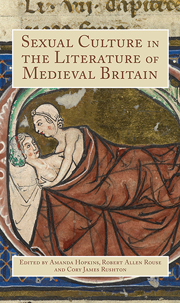Book contents
- Frontmatter
- Contents
- Introduction A Light Thrown upon Darkness: Writing about Medieval British Sexuality
- 1 ‘Open manslaughter and bold bawdry’: Male Sexuality as a Cause of Disruption in Malory's Morte Darthur
- 2 Erotic (Subject) Positions in Chaucer's Merchant's Tale
- 3 Enter the Bedroom: Managing Space for the Erotic in Middle English Romance
- 4 ‘Naked as a nedyll’: The Eroticism of Malory's Elaine
- 5 ‘How love and I togedre met’: Gower, Amans and the Lessons of Venus in the Confessio Amantis
- 6 ‘Bogeysliche as a boye’: Performing Sexuality in William of Palerne
- 7 Fairy Lovers: Sexuality, Order and Narrative in Medieval Romance
- 8 Text as Stone: Desire, Sex, and the Figurative Hermaphrodite in the Ordinal and Compound of Alchemy
- 9 Animality, Sexuality and the Abject in Three of Dunbar's Satirical Poems
- 10 The Awful Passion of Pandarus
- 11 Invisible Woman: Rape as a Chivalric Necessity in Medieval Romance
- Notes on Contributors
- Index
3 - Enter the Bedroom: Managing Space for the Erotic in Middle English Romance
Published online by Cambridge University Press: 05 August 2014
- Frontmatter
- Contents
- Introduction A Light Thrown upon Darkness: Writing about Medieval British Sexuality
- 1 ‘Open manslaughter and bold bawdry’: Male Sexuality as a Cause of Disruption in Malory's Morte Darthur
- 2 Erotic (Subject) Positions in Chaucer's Merchant's Tale
- 3 Enter the Bedroom: Managing Space for the Erotic in Middle English Romance
- 4 ‘Naked as a nedyll’: The Eroticism of Malory's Elaine
- 5 ‘How love and I togedre met’: Gower, Amans and the Lessons of Venus in the Confessio Amantis
- 6 ‘Bogeysliche as a boye’: Performing Sexuality in William of Palerne
- 7 Fairy Lovers: Sexuality, Order and Narrative in Medieval Romance
- 8 Text as Stone: Desire, Sex, and the Figurative Hermaphrodite in the Ordinal and Compound of Alchemy
- 9 Animality, Sexuality and the Abject in Three of Dunbar's Satirical Poems
- 10 The Awful Passion of Pandarus
- 11 Invisible Woman: Rape as a Chivalric Necessity in Medieval Romance
- Notes on Contributors
- Index
Summary
In the late fifteenth-century Squire of Low Degree, the incompetent protagonist woos a Hungarian princess in a way that seems to subject the romance genre to derivative, almost parodic, excess. This excess, however, offers particular insight into the representation of wooing in Middle English romance more broadly. While many romance heroines assume their suitors will display knightly prowess to win their love, this princess seems so aware of the Squire's shortcomings that she explains to him precisely what he must do, focusing on the rather boy-scout-like logistics of riding ‘Over hylles and dales, and hye mountaines, / In wethers wete, both hayle and raynes’, and lodging ‘under a tre, / Among the beastes wyld and tame’. Reminiscent here of how a Sir Thopas might understand chivalry, the text continues its overzealous attempt to ape romance when the princess exhaustively details the accoutrements that she expects from a suitor (203–30), and it is equally unable to find the right register when she offers to bankroll his required adventures (251–5). The envious steward's attempts to ruin the Squire by exposing his amorous inclinations are predictable enough; the results, however, have been seen as uncharacteristic of romance, since the king does not object to the Squire courting his daughter, but rather instructs the steward:
if the squiere come to-night,
For to speke with that lady bryght,
Let hym say whatsoever he wyll,
[…]
- Type
- Chapter
- Information
- Sexual Culture in the Literature of Medieval Britain , pp. 39 - 54Publisher: Boydell & BrewerPrint publication year: 2014



